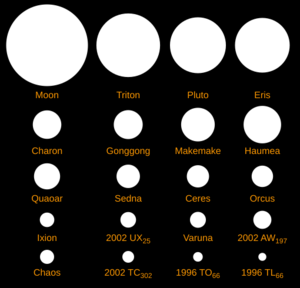19521 Chaos facts for kids
| Discovery | |
|---|---|
| Discovered by | Deep Ecliptic Survey |
| Discovery date | November 19, 1998 |
| Designations | |
| MPC designation | 19521 Chaos |
| 1998 WH24 | |
| TNO (cubewano) | |
| Orbital characteristics | |
| Epoch January 30, 2005 (JD 2453400.5) | |
| Aphelion | 50.269 AU |
| Perihelion | 40.929 AU |
| 45.599 AU | |
| Eccentricity | 0.102 |
| 309.1006 y | |
|
Average orbital speed
|
4.3931 km/s |
| 324.2844° | |
| Inclination | 12.0550° |
| 50.0103° | |
| 58.6836° | |
| Physical characteristics | |
| Dimensions | ~560 km |
|
Sidereal rotation period
|
3.985 (days) |
| 4.755 | |
19521 Chaos is a small, icy world located far out in our solar system. It's part of a region called the Kuiper belt, which is a bit like a second asteroid belt. However, the Kuiper belt is much bigger and further away than Neptune. Scientists found Chaos in 1998 using a powerful telescope. It is quite large for a Kuiper belt object, measuring about 560 kilometers (around 350 miles) across.
Contents
Discovering Chaos
Scientists found 19521 Chaos on November 19, 1998. It was discovered by a group of researchers called the Deep Ecliptic Survey. They used a special telescope at the Kitt Peak National Observatory to find it. This telescope is 4 meters (about 13 feet) wide.
Where is Chaos?
Chaos is a type of object called a Trans-Neptunian Object (TNO). This means it orbits the Sun further away than the planet Neptune. More specifically, Chaos is a cubewano. Cubewanos are TNOs that orbit the Sun in a nearly circular path. They are not affected much by Neptune's gravity.
Chaos takes a very long time to orbit the Sun. One full trip around the Sun takes about 309 Earth years! This is why it is so far away from us.
What's in a Name?
The name "Chaos" comes from ancient Greek stories. In these myths, Chaos was the very first thing that existed. It was a vast, empty space before the world and the first gods were formed. Scientists often name new space objects after figures from mythology.
Interesting Facts
- A jazz-fusion and progressive-rock band from Connecticut got their name from this minor planet.
- Chaos is quite bright for an object so far away. Its brightness helps scientists study it.

NASA JPL Small-Body Database Browser on 19521 Chaos
Images for kids
-
Size comparison between Pluto and Chaos
See also
 In Spanish: (19521) Chaos para niños
In Spanish: (19521) Chaos para niños






